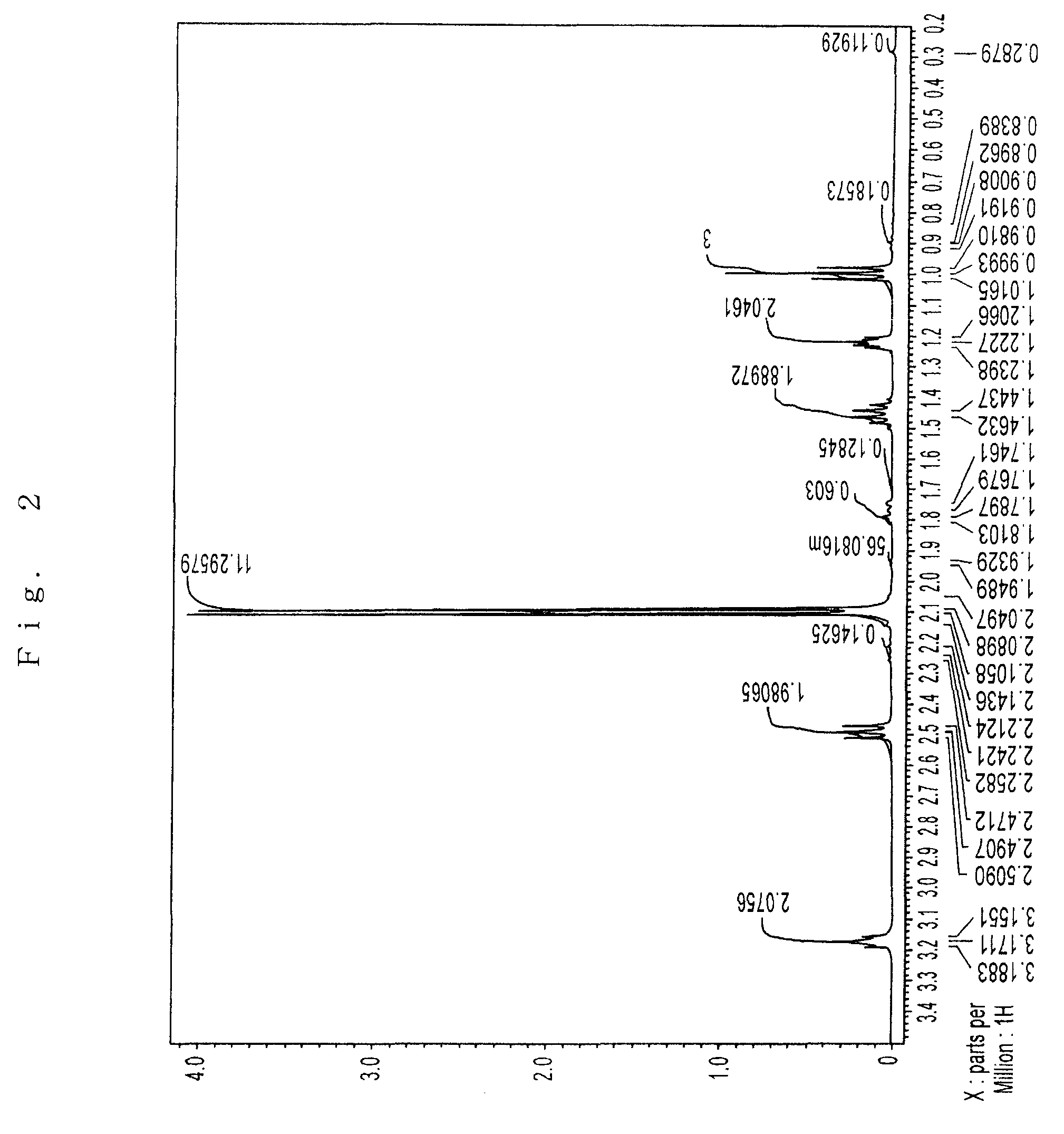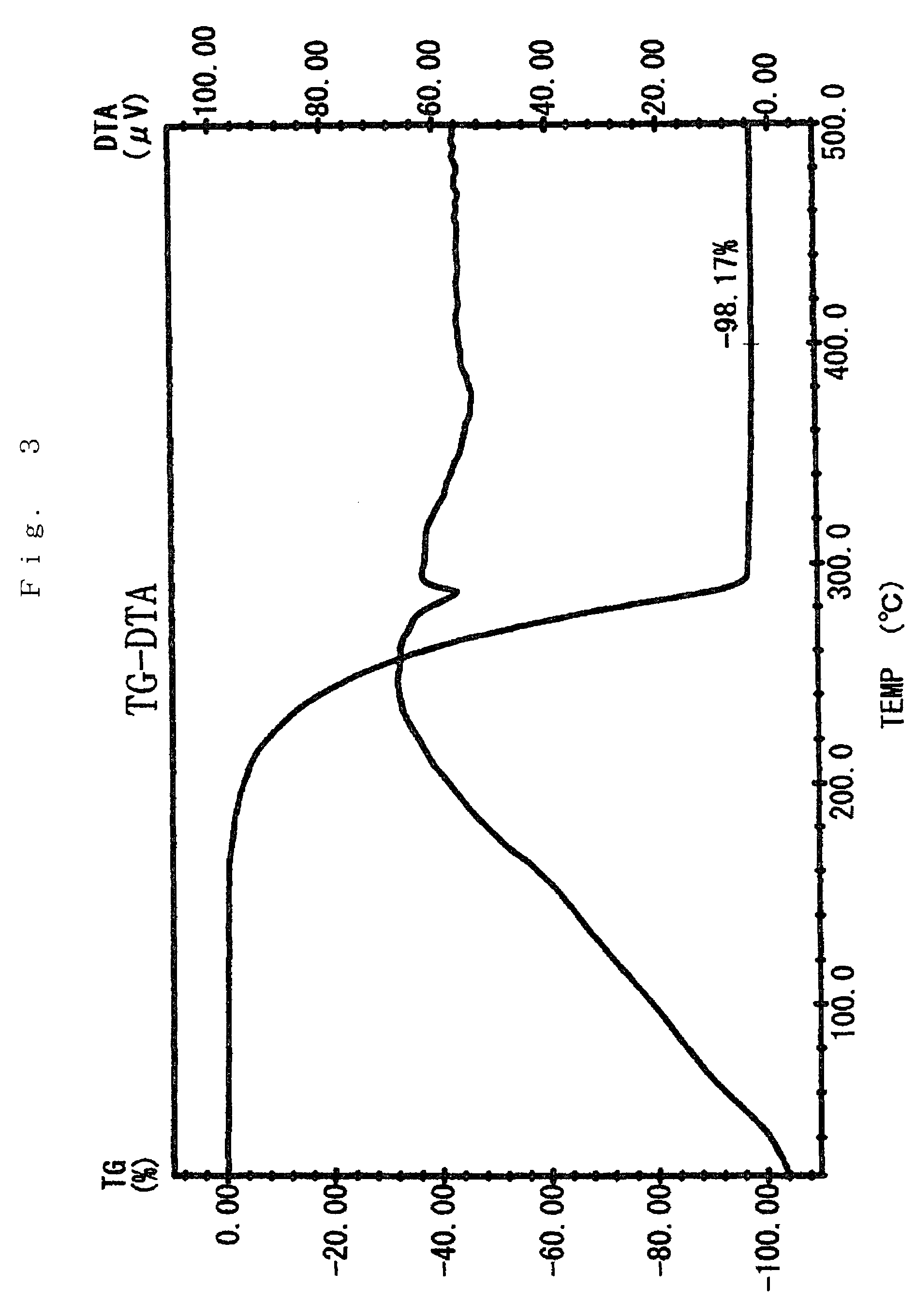Raw material for forming a strontium-containing thin film and process for preparing the raw material
a technology of strontium-containing thin films and raw materials, which is applied in the field of raw materials for forming strontium-containing thin films and the preparation of raw materials, can solve the problems of simultaneous thermal decomposition beyond control, low thermal stability of adducts, and a shortage of raw materials
- Summary
- Abstract
- Description
- Claims
- Application Information
AI Technical Summary
Benefits of technology
Problems solved by technology
Method used
Image
Examples
example 1
Preparation of Sr(PrMe4Cp)2
[0076]The inside of 1 L three-neck flask equipped with a thermometer, a stirrer, an inlet, and a reflux condenser was substituted with argon in vacuo. In the flask, 75 g (0.40 mol) of Na(PrMe4Cp) was dissolved in 600 ml of THF, which had been dehydrated and deoxygenated. To this was added 72 g (0.21 mol) of powder SrI2 with ice-cooling the flask, and then stirred for 8 hours at 40° C.
[0077]The solvent was removed under reduced pressure. The reaction mixture was dried, 600 ml of toluene which had been dehydrated and deoxygenated was added, and the mixture was stirred with heating to extract. The reaction mixture was allowed to stand, and filtered to give a clear filtrate. Toluene was removed under reduced pressure. The residue was dried at 100° C. under reduced pressure to give 89 g of pale yellow solid (initial dried product) having a melting point of about 130° C.
[0078]The solid was charged in a high vacuum distillation equipment, and held at 110 to 160°...
example 2
Formation of SrTiO3 Film Due to ALD Process that Uses Sr(PrMe4Cp)2 (1)
[0154]ALD was conducted by: bubbling a cylinder (A) filled with Sr(PrMe4Cp)2 obtained in Example 1 with Ar gas at 100 sccm at 170° C.; bubbling a cylinder (B) filled with Ti(OiPr)4 with Ar gas at 100 sccm at 40° C.; bubbling a cylinder (C) filled with water with Ar gas at 50 sccm at 20° C.; and flowing Ar as a purge gas at 200 sccm, under the condition of a pulse 1 sec and a purge 3 sec.
[0155]In an ALD chamber at a pressure of about 5 Torr, a Si substrate at a temperature of 300° C. was alternately subjected to 100 times of Sr cycle (A pulse-purge-C pulse-purge) and 100 times Ti cycle (B pulse-purge-C pulse-purge) to give an SrTiO3 film of 10 nm thickness.
example 3
Formation of SrTiO3 Film Due to ALD Process that Uses Sr(PrMe4Cp)2 (2)
[0156]A film is formed in a deposition chamber equipped with a chamber wall including a gas inlet port, a resistance-heating stage heater for heating a wafer and a wafer-setting lifter. The deposition chamber is connected through a pressure control valve to an exhaust pump and a cartridge heater embedded in the chamber wall is used to maintain the inside of the chamber at 160° C. Furthermore, the stage heater is set at 320° C. so that a wafer temperature may be 290° C. under substantially 0.3 Torr.
[0157]By use of a conveying arm, a Si wafer having a diameter of 300 mm is introduced from a conveying system to the deposition chamber and placed on the stage heater. Thereafter, 500 sccm of Ar gas is flowed and, by use of a pressure control valve, the pressure in the chamber is maintained at 1 Torr, followed by raising a wafer temperature.
[0158]Then, 100 g of Sr(PrMe4Cp)2 obtained in example 1 is charged in a bubbling ...
PUM
| Property | Measurement | Unit |
|---|---|---|
| melting point | aaaaa | aaaaa |
| temperature | aaaaa | aaaaa |
| melting point | aaaaa | aaaaa |
Abstract
Description
Claims
Application Information
 Login to View More
Login to View More - R&D
- Intellectual Property
- Life Sciences
- Materials
- Tech Scout
- Unparalleled Data Quality
- Higher Quality Content
- 60% Fewer Hallucinations
Browse by: Latest US Patents, China's latest patents, Technical Efficacy Thesaurus, Application Domain, Technology Topic, Popular Technical Reports.
© 2025 PatSnap. All rights reserved.Legal|Privacy policy|Modern Slavery Act Transparency Statement|Sitemap|About US| Contact US: help@patsnap.com



